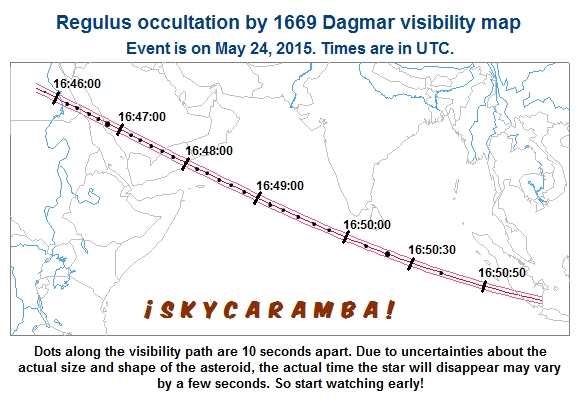¡SkyCaramba! Weekly astronomy blog for the week ending May 16, 2015
For the second time in about a year, the bright star Regulus will momentarily vanish from the sky because an asteroid will pass in front of it. The event is called an occultation. You won’t be able to see this event from everywhere in the world—at least not in person. Maybe a well placed web cam feed will enable you.
Asteroids pass in front of stars—usually dim ones—all the time. An astronomer who’s interested in an occultation usually has to have a powerful telescope and a very dark sky to watch the star wink. Regulus happens to be a naked eye star.
The place to be to see Regulus vanish on May 24, 2015 will be in a 20 to 30 kilometer wide path across the Arabian peninsula. Areas just north of Jeddah and Mecca in Saudi Arabia are well situated. So is Nishtun, Yemen. The islands of Male in the Indian Ocean are also in the right place. The visibility path ends in South Sumatra.
For those who really like to know, a would-be visibility path starts in the Washington, DC area, crosses the Atlantic Ocean, and reaches across northern Africa before heading to Saudi Arabia. But the sun will also be above the horizon in those places. So you won’t be able to see Regulus there.
Regulus will vanish for only 2.4 seconds at most. So you have to look at the star at just the right time. Turning away to see one of the night sky’s other wonders could cause you to miss the occultation. The occultation time north of Jeddah is at or about 16:46:44 Universal Time. By 16:48:04, the occultation has crossed the peninsula to Yemen’s coastline. It reaches the islands of Male at 16:49:48. Finally, it’s in South Sumatra by 16:50:55.
Of course, most people who want to can’t travel to see the occultation. A few people will set up web cams so others around the world can see this event. Hope for better results than the last time an asteroid occulted Regulus. Weather spoiled the view for most places in the visibility path on March 20, 2014. For one well placed web cam, the view was great until clouds moved in just minutes before Regulus was to disappear!
The asteroid in the 2014 occultation was 163 Erigone, and the vanishing act was supposed to last up to 14 seconds. In the 2015 event, 1669 Dagmar is the object that will pass in front of Regulus. Its eclipsing of the star will last just 2.4 seconds because it’s a much smaller asteroid. Not much is known about Dagmar. It orbits the sun between Mars and Jupiter. It’s thought to be about 43 kilometers wide. Careful observers who can report to astronomical observatories exactly where they are, when the occultation begins, and when it ends can help scientists learn more about Dagmar’s shape and size.
With or without an occultation, you can see Regulus from almost anywhere in the world. It’s about halfway up the western side of the sky at sunset this time of year. It’s the blue star at the bottom of the sickle shaped arrangements of stars in Leo.
¡SkyCaramba!
